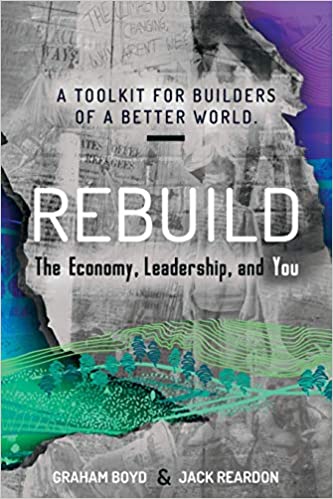
Richard Verboomen

A fish pays no attention to the water around it; rather, it is truly fully integrated in its habitat. It hasn’t developed the lenses to see the water, rather the water is the lens through which it sees everything else. What is our water?
The recently published book Rebuild: the Economy, Leadership, and You, a DIY guide for builders of a better world by Graham Boyd and Jack Reardon, could cite AQAL on each page, because the Integral approach is fully embedded at the core of its message; but I’m glad they then the book would double in length.
As each of us grows and unfolds, we each shine with our own unique qualities in our own unique way. I’ve worked with Graham over the past 3 years, and Rebuild is Graham doing just that: providing his own rich, experienced, practical version of what it means to be a busy, integrally informed practical activist building integral wholes. Jack and Graham stand for a world that works for all of us, and for all life. They stand for relentless optimism.
The flaws of the orange and green economical paradigms are clearly pointed at in the book; but more importantly it describes practical, concrete solutions to grow integrally whole teal and turquoise economical and financial alternatives, one single coherent approach across the six strata of ecosystems and their interactions:
6 – global social and economic
5 – local social and economic
4 – stakeholders, capitals (incorporation)
3 – organisation work, roles, tasks (OD)
2 – inter-personal
1 – inner-personal
A central thesis is that the outcomes of many excellent practices towards teal fall short of their ambitions because they act only in one or two strata, and / or lack coherence with practices in the other strata.
The constructive developmental framework of Otto Laske, built on the stages of meaning making of Kegan, are the backbone of the stage development model used as reference in the book.
The four quadrants are well integrated in the book, with a practical peer to peer dialogue scaffolding approach to grow individuals and teams skills safely in what Graham calls his Adaptive Way Dojo. This plays coherently with stratum 3 practices like sociocracy, Holacracy, etc. He also shows how incorporating as a traditional limited company is incoherent, cannot give the antifragile psychological safety needed for a teal company; how even many cooperatives, B-Corps and steward-owned companies lack elements needed for the first four strata to be integrally whole and coherent. His integrally whole incorporation, including the best of these forms, including all capitals and stakeholders, in governance and wealth share, is the link to building local and global economies that work for all.
These second tier adjustments, the shifts in the financials and economies they generate, are then a consequence of seeing the whole we are currently swimming in, and a coherent example of one possible AQAL solution.
You may not see it so easily in the book, but Graham starts business meetings with an invitation to a short silent meditation followed with a deep personal check in, allowing for true human connection. Sadly states are often forgotten when it comes to business, but not here. This is makes it easier for Graham to remember that we cannot separate ourself from nature, from society, from others. Our current fractured extractive economy, and the global environmental and social consequences, is evidence of the misunderstanding of our deep connection with nature and all living entities.
I can’t list everything; all the development lines and authors that are referred to in the book. Next to the wide cultural evolutionary background displayed throughout the book, one of the beautiful skills of Graham is to translate all of this into practical processes and tools for coherent growth across all six strata.
And finally, types are taken with a pinch of salt. Graham doesn’t want your unique glory to be dimmed; whether by being boxed into a small box, or by trying to make teal happen in the stratum your lenses show you, when the “water” that the other strata are keeps pushing you back to your old shape.
So, here they are, the 5 major ingredients of the integral map, used and applied in a very down to earth manner.

About the Author
Richard Verboomen is an integral coach and consultant at Now1, Brussels. You can find out more about him here.

Thank you for sharing this book review!